Lin Sun
TextlessRAG: End-to-End Visual Document RAG by Speech Without Text
Sep 10, 2025Abstract:Document images encapsulate a wealth of knowledge, while the portability of spoken queries enables broader and flexible application scenarios. Yet, no prior work has explored knowledge base question answering over visual document images with queries provided directly in speech. We propose TextlessRAG, the first end-to-end framework for speech-based question answering over large-scale document images. Unlike prior methods, TextlessRAG eliminates ASR, TTS and OCR, directly interpreting speech, retrieving relevant visual knowledge, and generating answers in a fully textless pipeline. To further boost performance, we integrate a layout-aware reranking mechanism to refine retrieval. Experiments demonstrate substantial improvements in both efficiency and accuracy. To advance research in this direction, we also release the first bilingual speech--document RAG dataset, featuring Chinese and English voice queries paired with multimodal document content. Both the dataset and our pipeline will be made available at repository:https://github.com/xiepeijinhit-hue/textlessrag
MemoryVLA: Perceptual-Cognitive Memory in Vision-Language-Action Models for Robotic Manipulation
Aug 26, 2025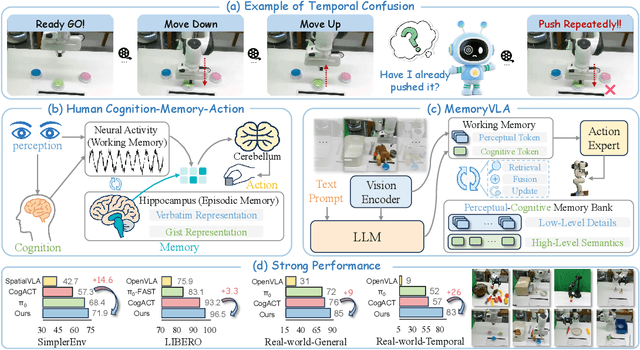
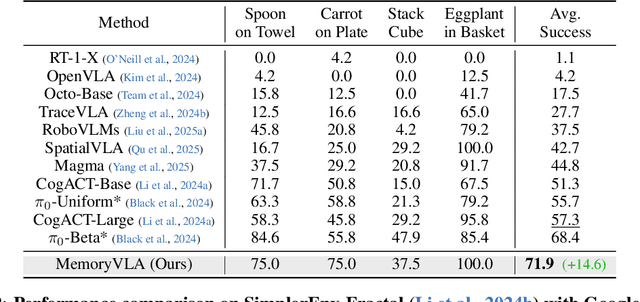
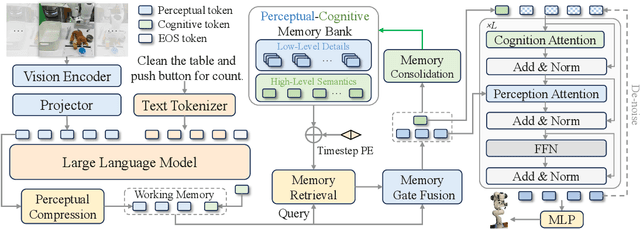
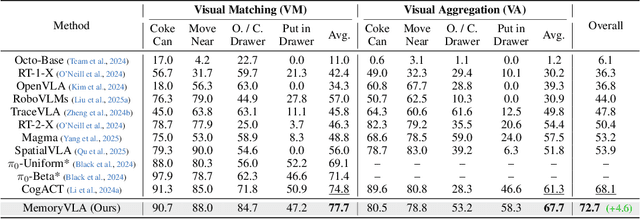
Abstract:Temporal context is essential for robotic manipulation because such tasks are inherently non-Markovian, yet mainstream VLA models typically overlook it and struggle with long-horizon, temporally dependent tasks. Cognitive science suggests that humans rely on working memory to buffer short-lived representations for immediate control, while the hippocampal system preserves verbatim episodic details and semantic gist of past experience for long-term memory. Inspired by these mechanisms, we propose MemoryVLA, a Cognition-Memory-Action framework for long-horizon robotic manipulation. A pretrained VLM encodes the observation into perceptual and cognitive tokens that form working memory, while a Perceptual-Cognitive Memory Bank stores low-level details and high-level semantics consolidated from it. Working memory retrieves decision-relevant entries from the bank, adaptively fuses them with current tokens, and updates the bank by merging redundancies. Using these tokens, a memory-conditioned diffusion action expert yields temporally aware action sequences. We evaluate MemoryVLA on 150+ simulation and real-world tasks across three robots. On SimplerEnv-Bridge, Fractal, and LIBERO-5 suites, it achieves 71.9%, 72.7%, and 96.5% success rates, respectively, all outperforming state-of-the-art baselines CogACT and pi-0, with a notable +14.6 gain on Bridge. On 12 real-world tasks spanning general skills and long-horizon temporal dependencies, MemoryVLA achieves 84.0% success rate, with long-horizon tasks showing a +26 improvement over state-of-the-art baseline. Project Page: https://shihao1895.github.io/MemoryVLA
GeoVLA: Empowering 3D Representations in Vision-Language-Action Models
Aug 12, 2025Abstract:Vision-Language-Action (VLA) models have emerged as a promising approach for enabling robots to follow language instructions and predict corresponding actions.However, current VLA models mainly rely on 2D visual inputs, neglecting the rich geometric information in the 3D physical world, which limits their spatial awareness and adaptability. In this paper, we present GeoVLA, a novel VLA framework that effectively integrates 3D information to advance robotic manipulation. It uses a vision-language model (VLM) to process images and language instructions,extracting fused vision-language embeddings. In parallel, it converts depth maps into point clouds and employs a customized point encoder, called Point Embedding Network, to generate 3D geometric embeddings independently. These produced embeddings are then concatenated and processed by our proposed spatial-aware action expert, called 3D-enhanced Action Expert, which combines information from different sensor modalities to produce precise action sequences. Through extensive experiments in both simulation and real-world environments, GeoVLA demonstrates superior performance and robustness. It achieves state-of-the-art results in the LIBERO and ManiSkill2 simulation benchmarks and shows remarkable robustness in real-world tasks requiring height adaptability, scale awareness and viewpoint invariance.
Evaluation is All You Need: Strategic Overclaiming of LLM Reasoning Capabilities Through Evaluation Design
Jun 05, 2025Abstract:Reasoning models represented by the Deepseek-R1-Distill series have been widely adopted by the open-source community due to their strong performance in mathematics, science, programming, and other domains. However, our study reveals that their benchmark evaluation results are subject to significant fluctuations caused by various factors. Subtle differences in evaluation conditions can lead to substantial variations in results. Similar phenomena are observed in other open-source inference models fine-tuned based on the Deepseek-R1-Distill series, as well as in the QwQ-32B model, making their claimed performance improvements difficult to reproduce reliably. Therefore, we advocate for the establishment of a more rigorous paradigm for model performance evaluation and present our empirical assessments of the Deepseek-R1-Distill series models.
CaMDN: Enhancing Cache Efficiency for Multi-tenant DNNs on Integrated NPUs
May 10, 2025Abstract:With the rapid development of DNN applications, multi-tenant execution, where multiple DNNs are co-located on a single SoC, is becoming a prevailing trend. Although many methods are proposed in prior works to improve multi-tenant performance, the impact of shared cache is not well studied. This paper proposes CaMDN, an architecture-scheduling co-design to enhance cache efficiency for multi-tenant DNNs on integrated NPUs. Specifically, a lightweight architecture is proposed to support model-exclusive, NPU-controlled regions inside shared cache to eliminate unexpected cache contention. Moreover, a cache scheduling method is proposed to improve shared cache utilization. In particular, it includes a cache-aware mapping method for adaptability to the varying available cache capacity and a dynamic allocation algorithm to adjust the usage among co-located DNNs at runtime. Compared to prior works, CaMDN reduces the memory access by 33.4% on average and achieves a model speedup of up to 2.56$\times$ (1.88$\times$ on average).
FineQ: Software-Hardware Co-Design for Low-Bit Fine-Grained Mixed-Precision Quantization of LLMs
Apr 28, 2025Abstract:Large language models (LLMs) have significantly advanced the natural language processing paradigm but impose substantial demands on memory and computational resources. Quantization is one of the most effective ways to reduce memory consumption of LLMs. However, advanced single-precision quantization methods experience significant accuracy degradation when quantizing to ultra-low bits. Existing mixed-precision quantization methods are quantized by groups with coarse granularity. Employing high precision for group data leads to substantial memory overhead, whereas low precision severely impacts model accuracy. To address this issue, we propose FineQ, software-hardware co-design for low-bit fine-grained mixed-precision quantization of LLMs. First, FineQ partitions the weights into finer-grained clusters and considers the distribution of outliers within these clusters, thus achieving a balance between model accuracy and memory overhead. Then, we propose an outlier protection mechanism within clusters that uses 3 bits to represent outliers and introduce an encoding scheme for index and data concatenation to enable aligned memory access. Finally, we introduce an accelerator utilizing temporal coding that effectively supports the quantization algorithm while simplifying the multipliers in the systolic array. FineQ achieves higher model accuracy compared to the SOTA mixed-precision quantization algorithm at a close average bit-width. Meanwhile, the accelerator achieves up to 1.79x energy efficiency and reduces the area of the systolic array by 61.2%.
TinyR1-32B-Preview: Boosting Accuracy with Branch-Merge Distillation
Mar 06, 2025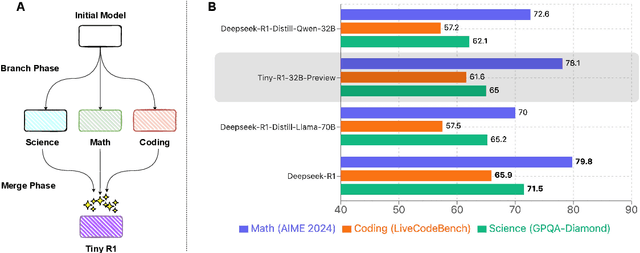

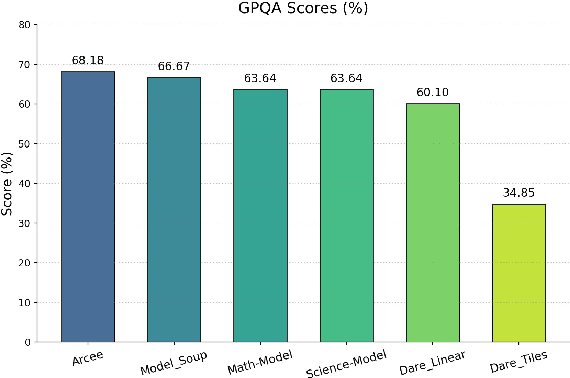

Abstract:The challenge of reducing the size of Large Language Models (LLMs) while maintaining their performance has gained significant attention. However, existing methods, such as model distillation and transfer learning, often fail to achieve high accuracy. To address this limitation, we introduce the Branch-Merge distillation approach, which enhances model compression through two phases: (1) the Branch Phase, where knowledge from a large teacher model is \textit{selectively distilled} into specialized student models via domain-specific supervised fine-tuning (SFT); And (2) the Merge Phase, where these student models are merged to enable cross-domain knowledge transfer and improve generalization. We validate our distillation approach using DeepSeek-R1 as the teacher and DeepSeek-R1-Distill-Qwen-32B as the student. The resulting merged model, TinyR1-32B-Preview, outperforms its counterpart DeepSeek-R1-Distill-Qwen-32B across multiple benchmarks, including Mathematics (+5.5 points), Coding (+4.4 points) and Science (+2.9 points), while achieving near-equal performance to DeepSeek-R1 on AIME 2024. The Branch-Merge distillation approach provides a scalable solution for creating smaller, high-performing LLMs with reduced computational cost and time.
Chain-of-Thought Matters: Improving Long-Context Language Models with Reasoning Path Supervision
Feb 28, 2025Abstract:Recent advances in Large Language Models (LLMs) have highlighted the challenge of handling long-context tasks, where models need to reason over extensive input contexts to aggregate target information. While Chain-of-Thought (CoT) prompting has shown promise for multi-step reasoning, its effectiveness for long-context scenarios remains underexplored. Through systematic investigation across diverse tasks, we demonstrate that CoT's benefits generalize across most long-context scenarios and amplify with increasing context length. Motivated by this critical observation, we propose LongRePS, a process-supervised framework that teaches models to generate high-quality reasoning paths for enhanced long-context performance. Our framework incorporates a self-sampling mechanism to bootstrap reasoning paths and a novel quality assessment protocol specifically designed for long-context scenarios. Experimental results on various long-context benchmarks demonstrate the effectiveness of our approach, achieving significant improvements over outcome supervision baselines on both in-domain tasks (+13.6/+3.8 points for LLaMA/Qwen on MuSiQue) and cross-domain generalization (+9.3/+8.1 points on average across diverse QA tasks). Our code, data and trained models are made public to facilitate future research.
LongAttn: Selecting Long-context Training Data via Token-level Attention
Feb 24, 2025Abstract:With the development of large language models (LLMs), there has been an increasing need for significant advancements in handling long contexts. To enhance long-context capabilities, constructing high-quality training data with long-range dependencies is crucial. Existing methods to select long-context data often rely on sentence-level analysis, which can be greatly optimized in both performance and efficiency. In this paper, we propose a novel token-level framework, LongAttn, which leverages the self-attention mechanism of LLMs to measure the long-range dependencies for the data. By calculating token-level dependency strength and distribution uniformity of token scores, LongAttn effectively quantifies long-range dependencies, enabling more accurate and efficient data selection. We filter LongABC-32K from open-source long-context datasets (ArXiv, Book, and Code). Through our comprehensive experiments, LongAttn has demonstrated its excellent effectiveness, scalability, and efficiency. To facilitate future research in long-context data, we released our code and the high-quality long-context training data LongABC-32K.
Stress Testing Generalization: How Minor Modifications Undermine Large Language Model Performance
Feb 18, 2025Abstract:This paper investigates the fragility of Large Language Models (LLMs) in generalizing to novel inputs, specifically focusing on minor perturbations in well-established benchmarks (e.g., slight changes in question format or distractor length). Despite high benchmark scores, LLMs exhibit significant accuracy drops and unexpected biases (e.g., preference for longer distractors) when faced with these minor but content-preserving modifications. For example, Qwen 2.5 1.5B's MMLU score rises from 60 to 89 and drops from 89 to 36 when option lengths are changed without altering the question. Even GPT-4 experiences a 25-point accuracy loss when question types are changed, with a 6-point drop across all three modification categories. These analyses suggest that LLMs rely heavily on superficial cues rather than forming robust, abstract representations that generalize across formats, lexical variations, and irrelevant content shifts. This work aligns with the ACL 2025 theme track on the Generalization of NLP models, proposing a "Generalization Stress Test" to assess performance shifts under controlled perturbations. The study calls for reevaluating benchmarks and developing more reliable evaluation methodologies to capture LLM generalization abilities better.
 Add to Chrome
Add to Chrome Add to Firefox
Add to Firefox Add to Edge
Add to Edge